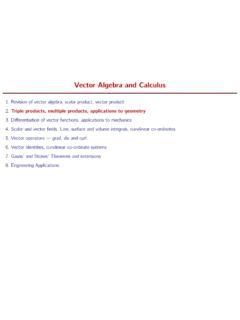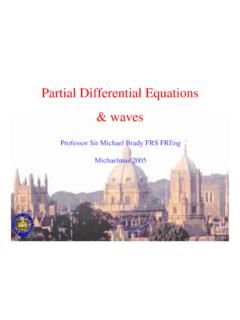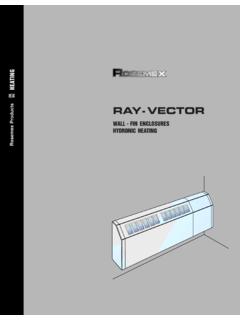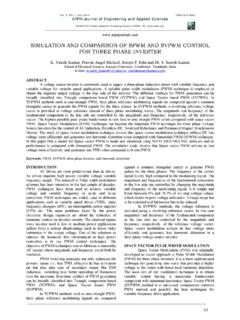Transcription of Vector Algebra and Calculus - Information …
1 Vector Algebra and of Vector Algebra , scalar product, Vector products, multiple products, applications to of Vector functions, applications to and Vector fields. Line, surface and volume integrals, curvilinear operators grad, div and Identities, curvilinear co-ordinate and Stokes Theorems and Applications6. Vector Operator Identities & Curvi Coords In this lecture we look at identities built from Vector operators. These operators behave both as vectors and as differential operators, so that the usual rules of taking the derivativeof, say, a product must be observed. We are laying the groundwork for the use of these identities in later parts of the Engineering course.
2 We then turn to derive expressions for grad, div and curl in curvilinear coordinates. After deriving general expressions, we will specialize to thePolar 1: curl gradU= U(x , y , z) is a scalar U= k / x / y / z U / x U / y U / z = 2U y z 2U z y + () + k()=0. can be thought of as a null 2: div curla= Fora(x , y , z) a Vector field: ( a) = / x / y / z / x / y / zaxayaz = 2az x y 2ay x z 2az y x+ 2ax y z+ 2ay z x 2ax z y= 0 Identity 3: divergence Suppose that U(r) is a scalar field v(r) is a Vector fieldand we are interested in the divergence of the productUv.
3 For example U(r) could be fluid density; and v(r) its instantaneous velocityThe product would be the mass flux per unit area. The productUvis a Vector field, so we can compute its divergence .. (Uv) =U( v) + ( U) v=Udivv+ (gradU) v In steps: (Uv) = x(U vx) + y(U vy) + z(U vz) =U vx x+U vy y+U vz z+vx U x+vy U y+vz U z=Udivv+v gradUIdentity 3: curl In a similar way, we can take the curl of the product of a scalar and Vector field fieldUv. The result should be a Vector field. And you re probably happy now to write down (Uv) =U( v) + ( U) 4: div ofa But things get trickier to guess when Vector or scalar products are involved!
4 Eg, not at all obvious that:div(a b) = curla b a curlb To show this, use the determinant: / x / y / zaxayazbxbybz = x[aybz azby] + y[azbx axbz] + z[axby aybx]=.. Vector operator identities in We could carry on inventing Vector identities for some time,but it is a bit, er, dull. Why bother at all, as they are in HLT?1. Since grad, div and curl describe key aspects of vectors fields, they often arise often in identities can save you a lot of time and hacking of partial derivatives, as we will see when we considerMaxwell s equation as an example Secondly, they help to identify other practically importantvector operators.
5 We now look at such an 5: curl(a b) (a b) = k / x / y / zaybz azbyazbx axbzaxby aybx curl(a b)x= y(axby aybx) z(azbx axbz)This can be written as the sum of four terms:ax + by y+ bz z bx + ay y+ az z + +by y+bz z ax +ay y+az z bx :ax bx xadd to term1, sub from term4 :bx ax x: sub from term2, add to term3 Hence (a b) = ( b)a ( a)b+ [b ]a [a ]b[a ] can be regarded as new, and very useful, scalar differential of the operator [a ] This is ascalar [a ] ax x+ay y+az z . Notice that the components ofadon t get touched by the differentiation.
6 Applied to a scalar field, results in a scalar field Applied to a Vector field results in a Vector fieldIdentity 6: curl(curla) for you to Amuse yourself by deriving the following important (curla) = grad(diva) 2awhere 2a= 2ax + 2ay + 2az k We are about to use it .. Eg using Identity 6: electromagnetic Background: Maxwell established a set of four Vector equations which are fundamental to working out how eletro-magnetic waves propagate. The entire telecommunications industry is built on these!divD= divB= 0curlE= tBcurlH=J+ tD In addition, we can assume the followingB= r 0HJ= ED= r 0 EExample :Show that in a material with no free charge, = 0, and with zero conductivity, = 0, the electric fieldEmust be a solution of the wave equation 2E= r 0 r 0( 2E/ t2).
7 Answer:divD= div( r 0E) = r 0divE= = 0; divE= 0divB= div( r 0H) = r 0divH= 0 divH= 0curlE= B/ t= r 0( H/ t)curlH=J+ D/ t=0+ r 0( E/ t)But curlcurlE= ( E) 2E, socurl [ r 0( H/ t)] = 2E r 0 t[curlH] = 2 EThen r 0 t r 0 E t = 2E r 0 r 0 2E t2= 2 EGrad, div, curl and 2in curvilinear It is possible to obtain general expressions for grad, div and curl in any orthogonal curvilinear co-ordinate system .. Need the scale We recall that the unit Vector in the direction of increasingu, withvandwbeing kept constant, is u=1hu r uwhereris the general position Vector , andhu= r u and similar expressions apply for the other co-ordinate directions.
8 Thendr=hud u u+hvd v v+hwd w in curvilinear Using the properties of the gradient of a scalar field obtained previously, U dr=d U and d U= U ud u+ U vd v+ U wd wIt follows that U (hu ud u+hv vd v+hw wd w) = U ud u+ U vd v+ U wd w The only way this can be satisfied for independentd u,d v,d wis whenGradUin curvilinear coords: U=1hu U u u+1hv U v v+1hw U w wDivergence in curvilinear If the curvilinear coordinates are orthogonal then volume is a cuboid (to 1st order in small things) andd V=huhvhwd u d v d w . However, it is not quite a cuboid: the area of twoopposite faces will differ as the scale parameters arefunctions ofu,v, (v+dv) dwwh (v) dwwh (v) duuuvThe scale params arefunctions of u,v,wh dvh (v+dv) duuv So the nett efflux from the two faces in the vdirn is= av+ av vd v hu+ hu vd v hw+ hw vd v d ud w avhuhwd ud w (avhuhw) vd ud v d wDivergence in curvilinear coordinates Repeat.
9 The nett efflux from the two faces in the vdirn is= av+ av vd v hu+ hu vd v hw+ hw vd v d ud w avhuhwd ud w= (avhuhw) vd ud v d w Now div is net efflux per unit volume, so sum up other faces:divad V= (auhvhw) u+ (avhuhw) v+ (awhuhv) w d ud v d w Then divide byd V=huhvhwd ud v d : div in curvi coords is:diva=1huhvhw (auhvhw) u+ (avhuhw) v+ (awhuhv) w Curl in curvilinear For an orthogonal curvi coord systemd S=huhvd ud w. But the opposite sides are not of same length!Lengths arehu(v)d u, andhu(v+d v)d +dvvvuah (v+dv) duuh (v) dudvu+du(v+dv)uau(v) Summing this pair contributes to circulation (in wdirn)au(v)hu(v)d u au(v+d v)hu(v+d v)d u= (huau) vd v d u Add in the other pair to find circulation per unit aread Chuhvd ud v=1huhv (huau) v+ (hvav) u Curl in curvilinear coordinates, To repeat, the part related to wis:d Chuhvd ud v=1huhv (huau) v+ (hvav) u Adding in the other two components gives.
10 Curla(u, v , w) =1hvhw (hwaw) v (hvav) w u+1hwhu (huau) w (hwaw) u v+1huhv (hvav) u (huau) v w You should show that can be written more compactly as:Curl in curvi coords is:curla(u, v , w) =1huhvhw hu uhv vhw w u v whuauhvavhwaw The Laplacian in curvilinear Substitute the components of gradUinto the expression for Much grinding gives the following expression for the Laplacianin general orthogonal co-ordinates:Laplacian in curvi coords is: 2U=1huhvhw u hvhwhu U u + v hwhuhv U v + w huhvhw U w .Grad, etc, the 3D polar There is no need slavishly to memorize the above derivations or their results.














